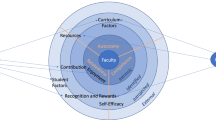Abstract
Previous research on professional certification has primarily focused on graduate certificates in intensive care nursing, writing certificates for practitioners, maintenance of certification in radiation oncology, and the certification of teachers and surgeons. Research on certification in the domain of business and management from an attitudinal–behavioral approach has been lacking. Social psychological theories provide potentially useful tools for explaining how attitudes, intentions, and behaviors are changed. The current study compared four intention-based models—the theory of planned behavior, the theory of self-regulation (TSR), the revised TSR (in which desire is a partial mediator), and the other revised TSR (in which desire is a full mediator)—in terms of their ability to predict the intentions of business and management students to obtain certification in their fields. Participants were drawn from the southern, middle, and northern areas of Taiwan. A structural equation model applied to a sample of 273 undergraduates demonstrated that attitudes, subjective norms, perceived behavioral controls, desires, intentions, and behaviors were associated with certification in business and management domains. The explanatory power of the revised TSR in which desire was a full mediator was superior to that of the competing models. Implications and future directions are discussed.


Similar content being viewed by others
References
Aberg, L. (2001). Attitudes. In P. E. Bajonet (Ed.), Traffic psychology today (pp. 119–137). USA: Kluwer Academic Publisher.
Ajzen, I. (1985). From intentions to actions: A theory of planned behavior. In J. Kuhl & J. Beckman (Eds.), Action control: From cognitions to behavior (pp. 11–39). Berlin: Springer.
Ajzen, I. (1987). Attitudes, traits, and actions: Dispositional prediction of behavior in personality and social psychology. Advances in Experimental Social Psychology, 20, 1–63.
Ajzen, I. (1991). The theory of planned behavior. Organizational Behavior and Human Decision Processes, 50, 179–211.
Ajzen, I., & Madden, T. (1986). Predictions of goal-directed behavior: Attitudes, intentions perceived behavioral control. Journal of Experimental Social Psychology, 22, 453–474.
Bagozzi, R. P. (1992). The self-regulation of attitudes, intentions and behavior. Social Psychology Quarterly, 55, 178–204.
Bagozzi, R. P., & Kimmel, S. K. (1995). A comparison of leading theories for the prediction of goal-directed behaviors. The British Psychological Society, 34, 437–461.
Bagozzi, R., & Yi, Y. (1989). The degree of intention formation as a moderator of the attitude–behavior relationship. Social Psychology Quarterly, 52, 266–279.
Bandura, A. (1989). Human agency in social cognitive theory. American Psychologist, 44, 1175–1184.
Bandura, A. (1997). Self-efficacy: The exercise of control. New York: Freeman.
Blanchard, C. M., Kupperman, J., Sparling, P., Nehl, E., Rhodes, R. E., Courneya, K. S., et al. (2008). Ethnicity and the theory of planned behavior in an exercise context: A mediation and the moderation perspective. Psychology of Sports and Exercise, 9, 527–545.
Broadhead-Fearn, D., & White, K. M. (2006). The role of self efficacy in predicting rule-following behaviors in shelters for homeless youth: A test of the theory of planned behavior. Journal of Social Psychology, 146, 307–325.
Brown, S., & Stayman, D. (1992). Antecedents and consequences of attitude toward the ad: A meta-analysis. Journal of Consumer Research, 19, 34–51.
Chai, C. S. (2010). The relationships among Singaporean preservice teachers’ ICT competencies, pedagogical beliefs and their beliefs on the espoused use of ICT. The Asia-Pacific Educational Researcher, 19, 387–400.
Cheng, P. Y., Lin, M. L., & Su, C. K. (2011). Attitudes and motivations of students taking professional certificate examinations. Social Behavior and Personality, 39, 1303–1314.
Chiou, W. B., & Wan, C. S. (2007). The dynamic change of self-efficacy in information searching on the Internet: Influence of experience valence and prior self-efficacy. Journal of Psychology, 141, 589–603.
Chou, C. (2010). Investigating the effects of incorporating collaborative action research into an in-service teacher training program. Procedia Social and Behavior Science, 2, 2728–2734.
Conner, M., & Sparks, P. (1996). Theory of planned behavior and health behaviors. In M. Conner & P. Norman (Eds.), Predicting health behavior (pp. 121–162). Buckingham: Open University Press.
Courneya, K. S., & Bobick, T. M. (2000). Integrating the theory of planned with the processes and stages of change in the exercise domain. Psychology of Sport and Exercise, 1, 41–56.
Cullati, S., Courvoisier, D. S., Charvet-Bérard, A. I., & Perneger, T. V. (2011). Desire for autonomy in health care decisions: A general population survey. Patient Education and Counseling, 83, 134–138.
Curran, P. J., West, S. G., & Finch, J. F. (1996). The robustness of test statistics to nonnormality and specification error in confirmatory analysis. Psychological Methods, 1, 16–29.
Epain, D. (2005). Medical reports in emergency contexts-hits and wounds. EMC-Medicine, 2, 448–467.
Fieulaine, N., & Martinez, F. (2010). Time under control: Time perspective and desire for control in substance use. Addictive Behavior, 35, 799–802.
Fishbein, M., & Ajzen, I. (1975). Belief, attitude, intention, and behavior: An introduction to theory and research. Reading, MA: Addison-Wesley.
Fornell, C., & Larcker, D. F. (1981). Evaluating structural equation models with unobservable variables and measurement error. Journal of Marketing Research, 48, 39–50.
Foxall, G. R. (1997). Marketing psychology: The paradigm in the wings. London: Macmillan.
Hair, J. F., Black, W. C., Babin, B. J., Anderson, R. E., & Tatham, R. L. (2006). Multivariate data analysis (6th ed.). Englewood Cliffs, NJ: Prentice-Hall.
Kline, R. B. (2005). Principles and practice of structural equation modeling (2nd ed.). New York: Guilford Press.
Kun, L., Ang, K., Erickson, B., Harris, J., Hoppe, R., Leibel, S., et al. (2005). Maintenance of certification for radiation oncology. International Journal of Radiation Oncology Biology Physics, 62, 303–308.
Laujunen, T., & Räsänen, M. (2004). Can social psychological models be used to promote bicycle helmet use among teenagers? A comparison of health belief model, theory of planned behavior and the locus of control. Journal of Safety Research, 35, 115–121.
Lee, M. C. (2010). Explaining and predicting users’ continuance intention toward e-learning: An extension of the expectation-confirmation model. Computers and Education, 54, 506–516.
Lin, B. J., & Chiou, W. B. (2010). Undergraduates’ intentions to take a second language proficiency test: A comparison of predictions from the theory of planned behavior and social cognition theory. Psychological Reports, 106, 798–810.
Luszczynska, A., Scholz, U., & Schwarzer, R. (2005). The general self-efficacy scale: Multicultural validation studies. Journal of Psychology, 139, 439–457.
Madden, T. J., Ellen, P. S., & Ajzen, I. (1992). A comparison of the theory of planned behavior and the theory of reasoned action. Personality and Social Psychology Bulletin, 18, 3–9.
Manstead, A. S. R., & Parker, D. (1995). Evaluating and extending the theory of planned behavior. In W. Stroebe & M. Hewstone (Eds.), European review of social psychology bulletin (Vol. 6, pp. 69–96). Chichester: Wiley.
Mussweiler, T., & Ruter, K. (2003). What friends are for! The use of routine standards in social comparison. Journal of Personality and Social Psychology, 85, 467–481.
Oh, H. K., Rizzo, T. L., So, H., Chung, D. H., Park, S. J., & Lei, Q. (2010). Preservice physical education teachers’ attributes related to teaching a student labeled ARHD. Teaching and Teacher Education, 26, 885–890.
Olson, J., & Zanna, M. (1993). Attitudes and attitude change. Annual Review of Psychology, 44, 117–154.
Pajares, F., & Miller, M. D. (1994). Role of self-efficacy and self-concept beliefs in mathematical problem solving: A path analysis. Journal of Educational Psychology, 86, 193–203.
Panagopoulos, G., Schein, M., & Wise, L. (1999). Perceived value of the American board of surgery certificate: A survey of 2000 fellows of the American college of surgeons. American College of Surgeons, 188, 1–5.
Parker, D., Manstead, R. S., Stradling, S. G., Reason, J. T., & Baxter, J. S. (1992). Intention to commit driving violations on the road. Transportation Research Part F, 1, 11–24.
Revelle, W., & Zinbarg, R. Z. (2009). Coefficients alph, beta, omega and the gld: Comments on Sijtsma. Psychometrika, 74, 145–154.
Santiano, N., & Daffurn, K. (2003). Registered nurses’ self-perceived level of competence following completion of a specialist graduate certificate. Australian Critical Care, 16, 16–23.
Schunk, D. H. (1989). Self-efficacy and achievement behaviors. Educational Psychology Review, 81, 173–208.
Shell, D. F., Murphy, C. C., & Bruning, R. (1989). Self efficacy and outcome expectancy mechanisms in reading and writing achievement. Journal of Educational Psychology, 81, 91–100.
Sheppard, B., Hartwick, J., & Warshaw, P. (1988). The theory of reasoned action: A meta-analysis of past research with recommendations for modification and future research. Journal of Consumer Research, 15, 325–343.
Shih, H. P. (2008). Using a cognition-motivation-control view to asses the adoption intention for web-based learning. Computer and Education, 50, 327–337.
Tabachnick, B. G., & Fidell, L. S. (1999). Using multivariate statistics (4th ed.). Boston, MA: Allyn & Bacon.
Yin, Z., & Boyd, M. P. (2000). Behavioral and cognitive correlates of exercise self-schemata. Journal of Psychology, 134, 269–282.
Zhang, J., Shi, L., Chen, D., Wang, J., & Wang, Y. (2009). Using the theory of planned behavior to examine effectiveness of an educational intervention on infant feeding in China. Preventive Medicine, 49, 529–534.
Acknowledgments
This research was supported by the National Science Council, Taiwan (Project No. NSC 98-2511-S-165-002-MY2).
Author information
Authors and Affiliations
Corresponding author
Rights and permissions
About this article
Cite this article
Cheng, PY., Hsu, PK. & Chiou, WB. Undergraduates’ intentions to take examinations for professional certification: examinations of four competing models. Asia Pacific Educ. Rev. 13, 691–700 (2012). https://doi.org/10.1007/s12564-012-9229-6
Received:
Revised:
Accepted:
Published:
Issue Date:
DOI: https://doi.org/10.1007/s12564-012-9229-6




